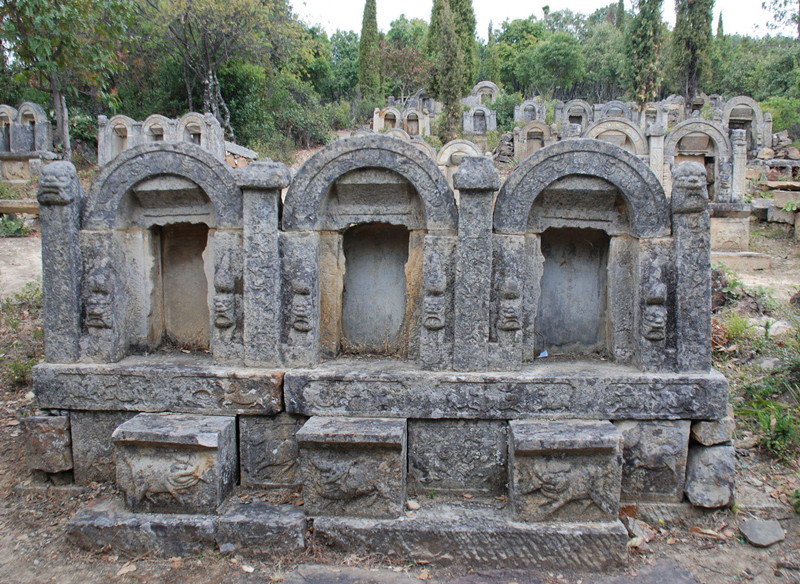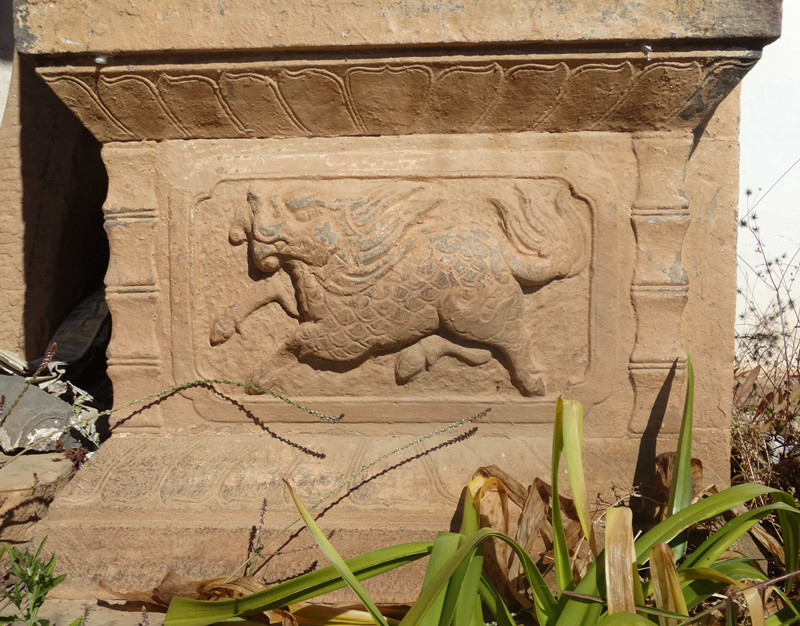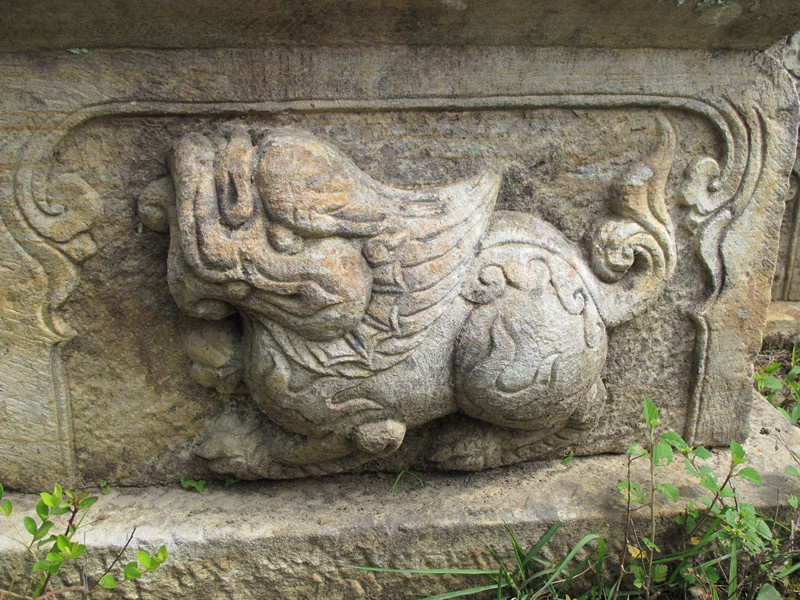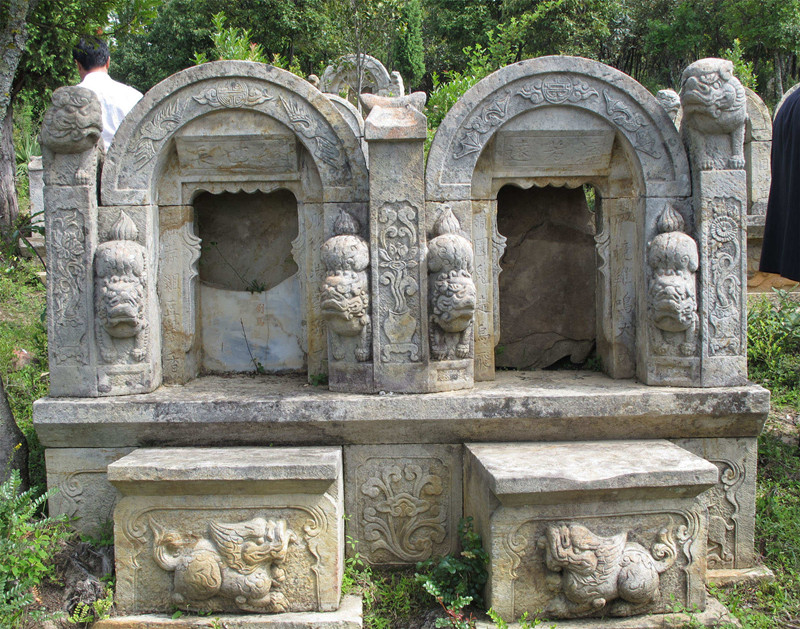 alt="Market Days in Menglian and Townships, Puer"
/>
alt="Market Days in Menglian and Townships, Puer"
/>
Ancient Tombs of Yingpan Village in Yongsheng County, Lijiang
Chinese Name: 永胜县营盘村墓群
English Name: Ancient Tombs of Yingpan Village in Yongsheng County, Lijiang
The Yingpan Village Tomb Complex is located in the northeastern part of Yushui Village, Liude Township, Yongsheng County, Lijiang City, Yunnan Province. Covering an area of approximately 304,000 square meters, the site contains 6,340 tombs, dating from the Ming Dynasty (Wanli Period, 1573–1619) to the Republic of China era, with an estimated usage span of around 400 years. The latest construction dates back to the late Ming or early Qing Dynasty, with the tombs belonging to surnames such as Hai, Lan, Wang, and Chen. Nearby, a castle sits on a gentle slope, covering 1.31 million square meters, surrounded by mountains to the east, west, and north, with an open area to the south. In May 2006, it was announced as a national key cultural relic protection unit, becoming part of the sixth batch of such sites.
Historical Significance
On May 25, 2006, the Yingpan Village Tomb Complex, recognized as ancient tombs from the Ming to Qing Dynasties, was approved by the State Council to be included in the list of the sixth batch of national key cultural relic protection units. The complex is situated in Yingpan Village, 30 kilometers southeast of Yongsheng County. The stele forest covers an area of about 5 square kilometers, with countless stone steles scattered across the landscape. The most concentrated tomb area is approximately 3 square kilometers. The tombs are built against the mountains, adorned with tall stone columns and steles, all hidden within lush greenery. There are tens of thousands of tombstones, arranged meticulously and artistically.
Detailed Introduction to Yingpan Village Tomb Complex
The tomb complex is constructed in harmony with the mountainous terrain, mostly consisting of domed stone tombs, which share similar structures. The tombstones can be categorized into two types: flat steles and deep steles. The steles are generally rectangular, with heights ranging from 1.5 to 2 meters and widths of about 1.5 to 4 meters. The bases are centered with qilin stones, flanked by deer and horse stones, floral stones, and flat stones, leaving a space in the middle for an altar. On either side of the altar are stele columns and 八字 (Ba Zi) stones, which bear inscriptions on stone tablets (also known as spirit tablets) and central columns. The heart of the stele features a semi-circular hat stone and rectangular flat stone. All inscriptions are in Chinese characters, written in a clear and strong regular script, showcasing exquisite craftsmanship, with the hat stone arching over the stele. The frames of the steles come in single and double frames. The decorations on the tomb surfaces, including divine flowers, auspicious clouds, treasure vases, and mythical creatures, are primarily in bas-relief and are remarkably beautiful.
Artistic Features
The designs on the semi-circular hat’s edges vary widely, featuring motifs such as phoenixes facing the sun, dragons playing with pearls, pairs of cranes greeting each other, dragons seizing treasures, lotus dragons, bats, and lizards. The central orb is particularly striking, depicting symbols of the sun, moon, and jewels; some use the yin-yang fish symbol, representing the Taiji symbol of Daoism. There are also engravings of the characters “福” (fortune) and “寿” (longevity), symbolizing the deceased’s blessings and longevity, alongside Confucian ancestral worship motifs wishing for descendants’ good fortune and success. The 八字 stone typically depicts motifs of young boys wishing for longevity, civil and military officials, plum blossoms, chrysanthemums, magpies, and auspicious vases, with patterns that signify auspiciousness. Two fierce lions are depicted in a hanging posture to convey dignity. The upper sections display sword-like brush strokes, with protective mythical beasts (often referred to as “dog heads”) and adornments like tile roofs, carved flower windows, or 八卦 diagrams (with punctures evenly carved).
Cultural Importance
The qilin statues on the base stones are diverse and unique, with no two identical in form, except for a few featuring jade belts, lotus flowers, and pairs of lions with fireballs. This reflects a rich qilin cultural atmosphere. On either side of the base stones, the deer and horse stones or floral patterns often depict the twelve zodiac animals; interestingly, the pig is notably absent from this representation. The intricately carved reliefs are lively and vivid.
The Yingpan Village Tomb Complex serves as an open-air stone art museum, unmatched in scale among the minority ethnic areas in the country. With nearly ten thousand tombstones that initially appear to share similar designs, closer inspection reveals unique details; the superb carving artistry makes each stone artifact a work of art with immense artistic value. The tomb complex embodies the history of Yingpan Village and serves as a successful example of how minority ethnic groups have accepted, absorbed, and integrated Han culture, showcasing the prosperous political, economic, and cultural era of its ancestors. It is an important historical building within Yingpan Village and stands as one of the historical traces of its culture and people. However, academic research on the Yingpan Village Tomb Complex remains limited, with few existing materials available. Therefore, it represents not only a valuable cultural heritage but also a significant artifact for uncovering the mysterious history of its inhabitants, filling gaps in the study of China’s ethnic minorities, and serving as a rare cultural tourism resource.
Current Condition and Threats
There are over 6,340 recorded tombs in the complex, of which more than 2,500 are well-preserved, while nearly 3,000 tombs have collapsed or severely weathered, facing numerous risks. The complex is surrounded by three natural villages and has several chaotic footpaths running through it. Livestock raised by villagers roam freely, with small animals nesting among the tombs and larger livestock grazing within the complex, leading to significant damage to the tombs due to rubbing and collapsing. In recent years, instances of tomb raiding have occurred occasionally, making management exceedingly difficult. Due to its remote mountain location, dense vegetation, and high humidity, natural damage to the tombstones is exceptionally severe.
Moreover, with the long passage of time, many tombstones exhibit signs of damage and weathering, including deterioration of the guardian beasts on the support columns and the collapse of blue stones on either side, causing the tombs to lean inward. The tombstones are made of loose silicate sandstone, which has endured centuries of wind, rain, and harmful gas erosion, leading to weathering, biological corrosion, and partial pulverization, flaking, and cracking. Inscriptions are often covered by moss, rendering them difficult to read; some are barely recognizable. The porous structure of the sandstone facilitates the penetration of harmful components deep into the stone, leading to damage. When moisture enters the stone’s crevices, it reacts with the sandstone, causing efflorescence and frost spalling, rapidly weathering and cracking the stones. Years of exposure to wind and rain have resulted in mold and moss growth on the rock surfaces, infiltrating the sandstone’s pores and causing biological corrosion.
In summary, without timely protective measures, these precious stone carvings may be lost forever.
Preservation Efforts
In September 2015, commissioned by the Yongsheng Cultural Broadcasting and Television Sports Bureau, our organization undertook the investigation, surveying, design, and scheme preparation for the protective fencing project around the Yingpan Village Tomb Complex. The protection project involves constructing protective fencing for the tomb complex and arranging visitor pathways. Its commencement will ensure effective preservation of the Yingpan Village Tomb Complex. The proposal was completed and submitted in October 2015, and in November of the same year, it received approval from the Yunnan Provincial Cultural Relics Bureau and entered the preparation phase for the project.

 7 Days GolfingTour
7 Days GolfingTour
 8 Days Group Tour
8 Days Group Tour
 8 Days Yunnan Tour
8 Days Yunnan Tour
 7 Days Shangri La Hiking
7 Days Shangri La Hiking
 11 Days Yunnan Tour
11 Days Yunnan Tour
 6 Days Yuanyang Terraces
6 Days Yuanyang Terraces
 11 Days Yunnan Tour
11 Days Yunnan Tour
 8 Days South Yunnan
8 Days South Yunnan
 7 Days Tea Tour
7 Days Tea Tour
 8 Days Muslim Tour
8 Days Muslim Tour
 12 Days Self-Driving
12 Days Self-Driving
 4 Days Haba Climbing
4 Days Haba Climbing
 Tiger Leaping Gorge
Tiger Leaping Gorge
 Stone Forest
Stone Forest
 Yunnan-Tibet
Yunnan-Tibet
 Hani Rice Terraces
Hani Rice Terraces
 Kunming
Kunming
 Lijiang
Lijiang
 Shangri-la
Shangri-la
 Dali
Dali
 XishuangBanna
XishuangBanna
 Honghe
Honghe
 Kunming
Kunming
 Lijiang
Lijiang
 Shangri-la
Shangri-la
 Yuanyang Rice Terraces
Yuanyang Rice Terraces
 Nujiang
Nujiang
 XishuangBanna
XishuangBanna
 Spring City Golf
Spring City Golf
 Snow Mountain Golf
Snow Mountain Golf
 Stone Mountain Golf
Stone Mountain Golf














 What Our Customers Say?
What Our Customers Say?
